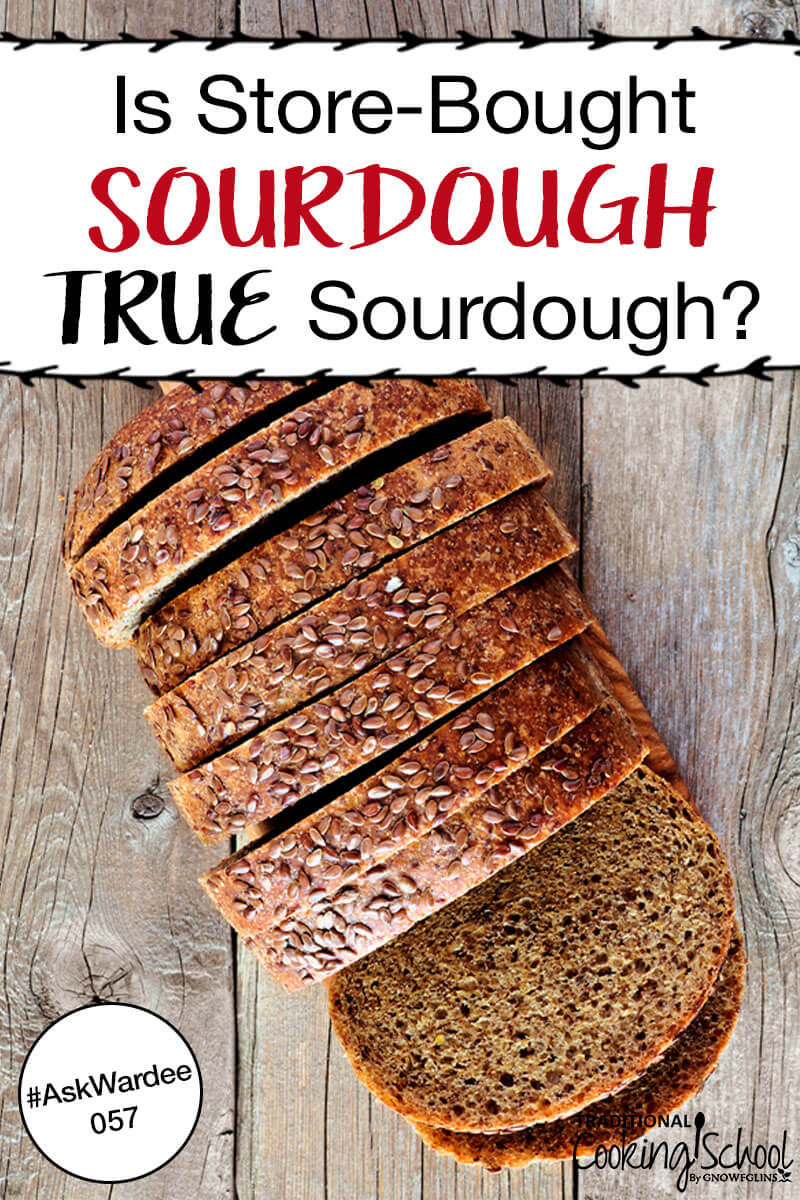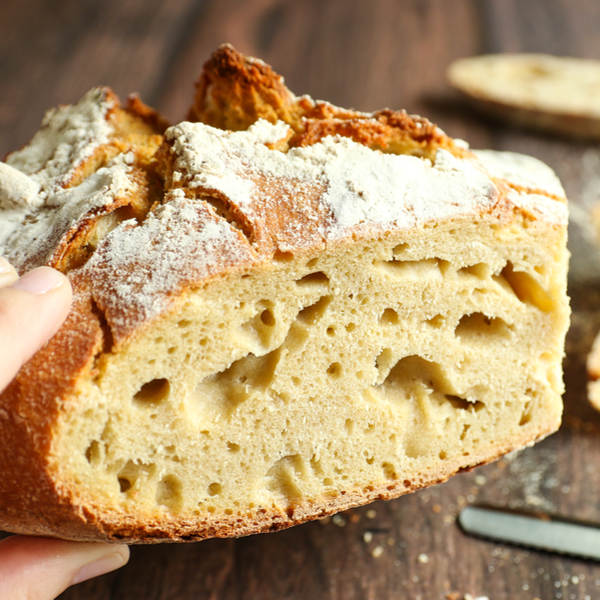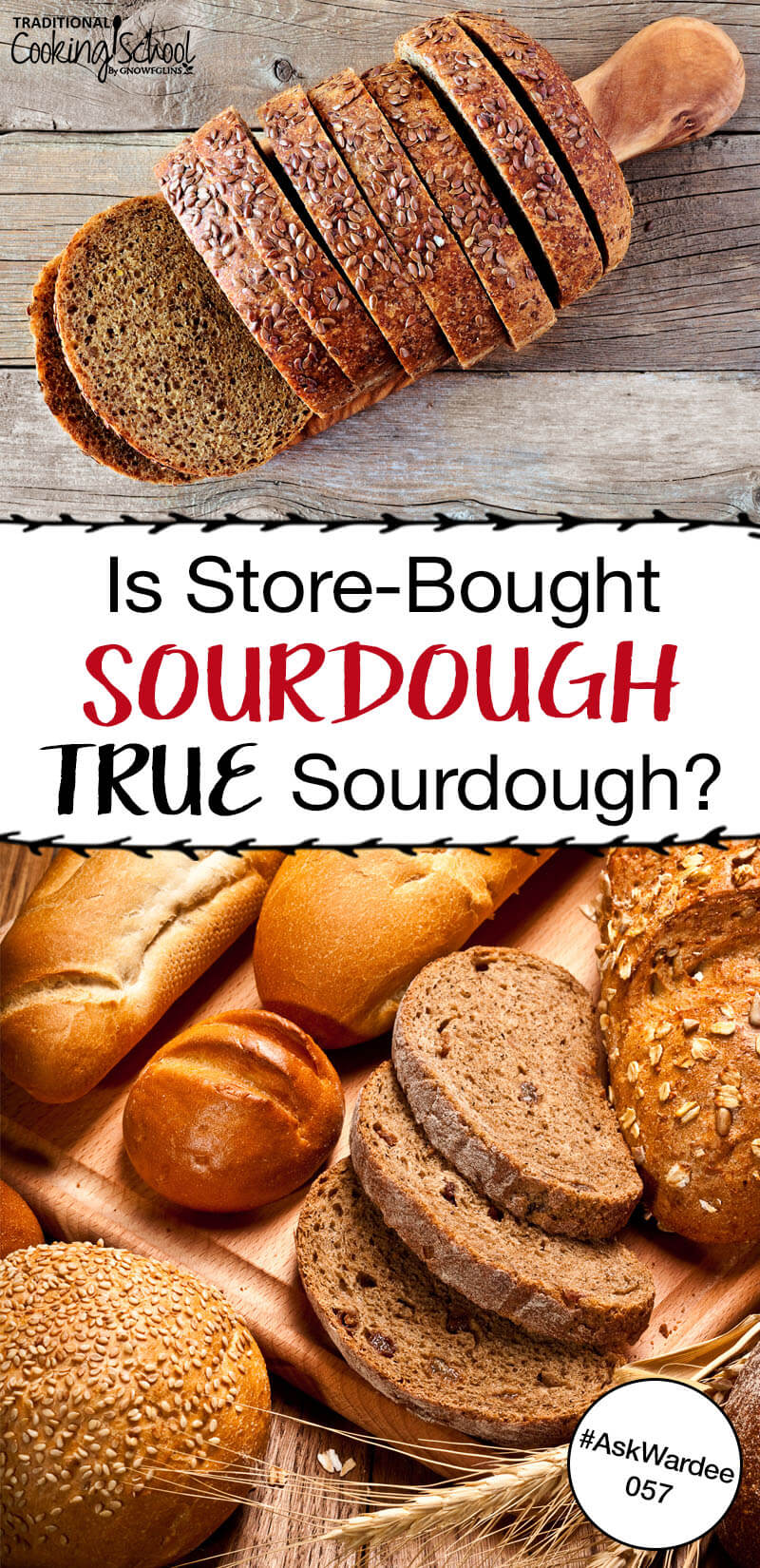
You’ve heard sourdough is the best bread to eat… and those loaves in the grocery store sure look awfully tempting…
…but are they TRUE sourdough? Real SOURDOUGH?
Lori L. is wondering the same thing (and she’s understandably skeptical):
Is the sourdough bread bought in the store made with a live culture or a flavoring?
Well, Lori… the short answer is no, most “sourdough” breads in the grocery store are not real sourdough. They’re fakers. 🙂
In today’s #AskWardee, I’m going to tell you more about what’s wrong with the grocery store sourdough breads and how to find real sourdough.
I broadcast #AskWardee live each Wednesday at 10am Pacific (1pm Eastern) on Periscope and Facebook Live. Both the podcast and video replay of this week’s show are below. Enjoy!
Subscribe to #AskWardee on iTunes, Stitcher, YouTube, or the Podcasts app.
The Question:
Lori L. asks:
Is the sourdough bread bought in the store made with a live culture or a flavoring?
My Answer: It’s Probably Not TRUE Sourdough…
Although there are exceptions, most “sourdough” breads in the grocery store are not true sourdough.
Which means that all those health benefits of sourdough are simply not there.
What’s The Point Of True Sourdough, Anyway?
Sourdough bread is really cool. Not only is it old-fashioned (and we’re suckers for old-fashioned stuff, aren’t we?)… sourdough makes bread more nutritious and digestible, which can be great news for those who are sensitive to gluten, wheat, or grains in general.
How can this be? It’s all because of the sourdough starter — a culture of beneficial bacteria and yeast suspended in a flour/water batter. When combined with flour, the starter’s friendly creatures (bacteria and yeasts) consume the starches and sugars in the grains.
While they’re eating, they’re breaking down (pre-digesting) gluten and leaving behind beneficial acids (that’s the sour flavor). Also, the yeasts in particular give off a lot of gas while eating, and it’s those air bubbles that lift the dough and cause it to rise.
So… a lot more is going on than just a sour taste. 🙂
True sourdough is a wonderful food! And worth getting right.
Some in our family have gluten sensitivity yet are able to eat sourdough bread without issue. (This is our experience and others may or may not have a similar experience.)
Why Isn’t Store-Bought Sourdough TRUE Sourdough?
Many store-bought “sourdough” breads use just a small amount of sourdough starter and throw that and other flavors in there to give the bread a sourdough taste — while the action of rising the bread is done with commercial yeast.
Because of this, the store-bought breads have a “sour” flavor yet none of the nutritional benefits.
Other store-bought sourdough breads might be leavened through sourdough, yet not long enough or only some of the flour was combined with the starter — which means the bread is not as nutritious as it could (and should) be.
How To Find True Sourdough Bread
If you don’t make it yourself, you’ll have to look hard to find true sourdough bread.
Usually, it comes from an artisan bakery or baker at the farmer’s market who knows, appreciates, and believes in the traditional cooking method — and wants to share not only the amazing flavors but the health benefits with the world.
Just get your baker talking to find out the answers to these questions. (I put the right answer in parentheses with each question.)
- (yes) are they using only sourdough starter to leaven and flavor the bread?
- (8 to 12 hours or more) how long is the dough fermented with the starter (8 to 12 hours or more is preferable)?
- (no) is any of the flour not soured by the sourdough starter for the duration of fermenting?
- (no) do they add any additional commercial yeast?
- (yes is preferable) are they using some or all whole grains?
- (yes is a bonus) are they using some or all sprouted grains? (this improves digestion even more)
How To Make Your Own Sourdough Bread
Because a loaf of true sourdough bread might cost $4 to $6 or more… you might find that you’re reserving purchasing it for special occasions and want to make your own instead. You’ll save a bundle!
Here are recipes for you:
- How To Make A Sourdough Starter
- No-Knead Sourdough Einkorn Bread (includes sourdough starter instructions)
- Sourdough English Muffins
- Gluten-Free Sourdough Bread (with FREE Video)
- Not-So-Dense (Or Sour) Sourdough Bread
- Sourdough Sandwich Bread
- 26 Sourdough Bread Recipes
How To Make Sourdough Bread Even BETTER
For some years now, my family has been baking and eating REAL sourdough bread made with ancient grains.
Ancient grains — like spelt and einkorn — have less and gentler gluten as well as less and gentler starch.
Combine those benefits with using sourdough to prepare them — and you have even better bread.
If you’re interested in ancient grains and sourdough, be sure to try my free recipe for No-Knead Artisan Sourdough Einkorn Bread. This recipe comes with instructions for starting your own sourdough starter, so you’ll get everything you need!
Helpful Links
- Debunking 4 Sourdough Myths (& How To Overcome Them)
- No-Knead Sourdough Einkorn Bread (includes sourdough starter instructions)
- Can I Feed My Sourdough Starter Different Flours? #AskWardee 021
- Feeding Your Sourdough Starter… More Than Just Flour! #AskWardee 150
- Can I Use Reverse Osmosis Water For Fermenting, Culturing, & Sourdough? #AskWardee 138
- How To Freeze Your Sourdough Starter {Best Way} #AskWardee 059
- Where to buy einkorn
- Is Sourdough Gluten-Free?
- Why Won’t My Sourdough Bread Rise? How To Know When Your Starter Is Strong Enough For Bread-Baking
Have you ever been able to find real sourdough bread at the store, farmers’ market, or bakery? Do you make or buy sourdough bread?
We only recommend products and services we wholeheartedly endorse. This post may contain special links through which we earn a small commission if you make a purchase (though your price is the same).




Hello, My homemade sourdough bread is coming out more reliable now, rises pretty well with no yeast, and tastes like….not sourdough, but not yeasty either. It does keep well. It obviously doesn’t have the taste of a good regular yeast raised bread, but it also doesn’t have the sour flavor much to speak of, if any–which is the part I love. I have a homemade culture and a San Francisco sourdough culture from Cultures for Health. First is about 2 months old, the other 1 month. What can I add to my bread recipes (tried several) for flavoring to make it more sour? I did some research that said a less water, more flour starter is more sour so am doing that and it seems to be when raw but not the bread. I do ferment the entire amount of flour, using part whole wheat but a lot of unbleached white as I like the white sourdough type when I want sourdough. None of us has allergies or gluten problems.
The store bought one I love contains yeast–like you said, but also lactic acid right at the end of ingredients and is described on label as San Francisco “style” sourdough bread. Is there anything I can add to full sourdough starter raised dough to add more sour taste to the other health benefits and when would I add it? Was thinking possibly vinegar as I know you can put a touch in any bread and it keeps better–but that might disrupt the rising, or baking soda? Or is there a baking substance of lactic acid, if that’s what’s doing it for the store bought? I’ve read that it gets tarter as the starter ages, but I don’t want to wait many more loaves of bread before getting a nice sour one. Thanks!
Me again–did find one solution. I found a sourdough bread recipe called Extra Tangy Sourdough on the King Arthur site. It has some additional hints for making a more tangy sourdough. One is to leave it in the refrigerator longer–which I’ve read on your info. The other is to add citric acid, which I guess is also known as sour salt. It’s the same thing you add to fruit to keep from browning while you’re canning or freezing and available in home canning store areas. The directions are to add no more than 1/8 tsp. per cup of flour used.
I called the hotline to make sure it was the citric acid I thought it was–and the rep. said she adds it to the flour at the start so it goes into the fridge for the fermentation and also mixed in with the additional flour to knead. The recipe says to add it to the 2 c. of flour NOT put into the initial fridge dough (3 c. into the fridge). I’m going to try this recipe later this afternoon and leave it in the fridge till Monday a.m.,depending on looks, and am going to follow the recipe exactly for the first time. If that doesn’t do what I want, then I will add more flour to the initial dough for fermenting & less afterwards.
I also checked on the safety of citric acid/sour salt. The only time it has health hazards is if consumed in large quantities and very often–otherwise normal usage of it on fruit or other foods is safe. Sour gummy bears have it to make the biting flavor when you pop them in your mouth–never knew what it was! Thanks and if you have any other suggestions, please let me know. Lactic acid was the last ingredient on the store bought bread so that might be something else or vinegar, etc?
Hi Barb,
If you use a longer souring time with less starter you’ll end up with a more sour and tangy bread.
Also, don’t use recipes with baking soda (it neutralizes sour).
To our knowledge, lactic acid is the acid produced by the starter’s organisms.
Let us know how the recipe goes. 🙂
Millie Traditional Cooking School Support
I’m also interested, as Barb M., in how to make a tangier bread. I make the “bucket bread” from your sourdough ebook, and although the dough is in the fridge for up to a week, it has never had the tangy flavor I love. My sourdough starter is 9 months old. It did sit in the refrigerator for a few months in the summer while I was canning. I stirred in the hooch as I heard that helps the sour flavor but no luck. Suggestions? Thanks
So I moved to Munich, Germany from the U.S. about 5 months ago and my search for true sourdough ended! If you shop in a local bakery (and theres literally one on every block, sometimes two competitors directly across from each other) then you literally can’t find bread that’s -not- made with sourdough culture.
I remember the first time I went in to a bakery, whipped out my google translate, and asked “Haben Sie sauertiegbrot?” (Do you have sourdough bread?) and I got a very confused look, followed by them pointing to every loaf of bread on the shelf. I knew I’d arrived in heaven.
As far as whether it is true sourdough; I have a sensitivity to gluten which will manifest itself with joint pain within 2-3 days of consuming. Happy to report I dont have any of that with most every bread I’ve tried here. As far as shelf stability, it goes bad in about 2 days, BUT Ive learned to just freeze it and re-toast and it comes out wonderfully.
I have to laugh when I read this article, because I had to find out the hard way. We loved sourdough bread for so many years, when I started baking breads a lot at home, it was one of the first 3-5 types of bread I tried. I did everything I should, according to hundreds of articles I read, to make sourdough bread, but I was incredibly frustrated after dozens of attempts, I still couldn’t get the bread I wanted. Even my kids said it tasted good and tasted like sourdough, I just wasn’t happy with how sour it was.
I ended up coming up with a multi-day process to make the sourdough bread that I ended up being fairly happy with. But when I got to that point, it just made me very sure there was no way that the sourdough bread we bought in stores went to that much trouble to make what I had. Then I read some articles about how to add more sour flavor to your sourdough, and that store-bought breads often do these things, and then I realized it’s just easier for stores to make normal bread that they add sourdough flavor to than it is to actually make real sourdough bread. That’s when I realized that most people who love sourdough bread don’t actually know that what they love is not sourdough bread.
Anyway, I rarely make sourdough bread any more and of course I never buy it from stores, the same as any other bread. The original reason I stopped buying store-bought breads was one summer after I realized I left some hamburger buns out on a shelf in my kitchen and after a couple of months it was still perfect, no mold. I was amazed at the amount of preservatives it must take to achieve that, how unhealthy that must be, and I’ve made all our bread at home ever since.
People often ask me how I can do that, because it must take so much time, but I just tell them the truth: after making breads thousands of times, I can make a couple of loaves of white bread for dinner in 2 hours flat. Most people just don’t know how easy it really is when you get good at it. So, I can literally whip out bread any time I want, and it’s better than any store-bought bread, even artisan “fresh-baked” breads.
Speaking of which, talking to a grocery store baker clued me into the “secret” they never tell you about “fresh” breads. They’re mass produced and par-baked, then frozen to ship to the stores. There they finish the “baking” process in minutes. No store where you buy fresh baked breads actually makes the bread there. Unless you actually see them mixing and kneading it. The guy who told me knew me shopping there for years and told me because he didn’t have any “baked”. He said just take it home and bake it for like 10 minutes and it’s the same as in-store, haha.